Finite Element Evaluation of the Electric Field Distribution in a Non-Homogeneous Environment
Abstract
:1. Introduction
2. Materials and Methods
2.1. Electric Field Distribution Using FEA
2.2. Scaffold Preparation and Cell Culture
2.2.1. Materials for Scaffold Preparation
2.2.2. Synthesis of an SAP Functionalized with Laminin Adhesion Sequence
2.2.3. Preparation of the 3D Scaffold
2.2.4. Cell Cultures
2.2.5. Electroporation Procedure
2.2.6. Fluorescent Staining after Electroporation
3. Results
3.1. Numerical Analysis of Relevant Cases
3.2. Electroporation of Cell Cultures
3.3. FEA vs. Experimental Results
4. Conclusions
Author Contributions
Funding
Institutional Review Board Statement
Data Availability Statement
Acknowledgments
Conflicts of Interest
References
- Campana, L.G.; Edhemovic, I.; Soden, D.; Perrone, A.M.; Scarpa, M.; Campanacci, L.; Cemazar, M.; Valpione, S.; Miklavčič, D.; Mocellin, S.; et al. Electrochemotherapy—Emerging Applications Technical Advances, New Indications, Combined Approaches, and Multi-Institutional Collaboration. Eur. J. Surg. Oncol. 2019, 45, 92–102. [Google Scholar] [CrossRef] [PubMed]
- Campana, L.G.; Quaglino, P.; Bechara, F.G.; Marconato, R.; Ascierto, P.A.; Caracò, C.; Brizio, M.; Clover, J.; Bourke, M.; Valpione, S.; et al. Electrochemotherapy in Melanoma: A European e-Delphi Survey to Define a Consensus on Indications, Treatment Modalities and Quality Indicators. Eur. J. Surg. Oncol. 2019, 45, e18. [Google Scholar] [CrossRef]
- De Virgilio, A.; Ralli, M.; Longo, L.; Mancini, P.; Attanasio, G.; Atturo, F.; De Vincentiis, M.; Greco, A. Electrochemotherapy in Head and Neck Cancer: A Review of an Emerging Cancer Treatment (Review). Oncol. Lett. 2018, 16, 3415–3423. [Google Scholar] [CrossRef] [PubMed]
- Gehl, J.; Sersa, G.; Matthiessen, L.W.; Muir, T.; Soden, D.; Occhini, A.; Quaglino, P.; Curatolo, P.; Campana, L.G.; Kunte, C.; et al. Updated Standard Operating Procedures for Electrochemotherapy of Cutaneous Tumours and Skin Metastases. Acta Oncol. 2018, 57, 874–882. [Google Scholar] [CrossRef]
- Sersa, G.; Cufer, T.; Paulin, S.M.; Cemazar, M.; Snoj, M. Electrochemotherapy of Chest Wall Breast Cancer Recurrence. Cancer Treat. Rev. 2012, 38, 379–386. [Google Scholar] [CrossRef]
- Marty, M.; Sersa, G.; Garbay, J.R.; Gehl, J.; Collins, C.G.; Snoj, M.; Billard, V.; Geertsen, P.F.; Larkin, J.O.; Miklavcic, D.; et al. Electrochemotherapy—An Easy, Highly Effective and Safe Treatment of Cutaneous and Subcutaneous Metastases: Results of ESOPE (European Standard Operating Procedures of Electrochemotherapy) Study. Eur. J. Cancer Suppl. 2006, 4, 3–13. [Google Scholar] [CrossRef]
- Ivorra, A.; Villemejane, J.; Mir, L. Electrical Modeling of the Influence of Medium Conductivity on Electroporation. Phys. Chem. Chem. Phys. PCCP 2010, 12, 10055–10064. [Google Scholar] [CrossRef]
- Pucihar, G.; Kotnik, T.; Kandušer, M.; Miklavčič, D. The Influence of Medium Conductivity on Electropermeabilization and Survival of Cells in Vitro. Bioelectrochemistry 2001, 54, 107–115. [Google Scholar] [CrossRef]
- Ruzgys, P.; Jakutavičiūtė, M.; Šatkauskienė, I.; Čepurnienė, K.; Šatkauskas, S. Effect of Electroporation Medium Conductivity on Exogenous Molecule Transfer to Cells in Vitro. Sci. Rep. 2019, 9, 1436. [Google Scholar] [CrossRef]
- Silve, A.; Leray, I.; Poignard, C.; Mir, L.M. Impact of External Medium Conductivity on Cell Membrane Electropermeabilization by Microsecond and Nanosecond Electric Pulses. Sci. Rep. 2016, 6, 19957. [Google Scholar] [CrossRef]
- Ongaro, A.; Pellati, A.; Caruso, A.; Battista, M.; De Terlizzi, F.; De Mattei, M.; Fini, M. Identification of in Vitro Electropermeabilization Equivalent Pulse Protocols. Technol. Cancer Res. Treat. 2011, 10, 465–473. [Google Scholar] [CrossRef] [PubMed]
- Dermol, J.; Pakhomova, O.N.; Pakhomov, A.G.; Miklavčič, D. Cell Electrosensitization Exists Only in Certain Electroporation Buffers. PLoS ONE 2016, 11, e0159434. [Google Scholar] [CrossRef]
- Batista Napotnik, T.; Miklavčič, D. In Vitro Electroporation Detection Methods—An Overview. Bioelectrochemistry 2018, 120, 166–182. [Google Scholar] [CrossRef] [PubMed]
- Miklavčič, D.; Pavšelj, N.; Hart, F.X. Electric Properties of Tissues. In Wiley Encyclopedia of Biomedical Engineering; John Wiley & Sons, Inc.: Hoboken, NJ, USA, 2006; ISBN 978-0-471-74036-0. [Google Scholar]
- Sel, D.; Cukjati, D.; Batiuskaite, D.; Slivnik, T.; Mir, L.M.; Miklavcic, D. Sequential Finite Element Model of Tissue Electropermeabilization. Biomed. Eng. IEEE Trans. 2005, 52, 816–827. [Google Scholar] [CrossRef]
- Čorović, S.; Županič, A.; Kranjc, S.; Al Sakere, B.; Leroy-Willig, A.; Mir, L.M.; Miklavčič, D. The Influence of Skeletal Muscle Anisotropy on Electroporation: In Vivo Study and Numerical Modeling. Med. Biol. Eng. Comput. 2010, 48, 637–648. [Google Scholar] [CrossRef]
- Ivorra, A.; Al-Sakere, B.; Rubinsky, B.; Mir, L.M. In Vivo Electrical Conductivity Measurements during and after Tumor Electroporation: Conductivity Changes Reflect the Treatment Outcome. Phys. Med. Biol. 2009, 54, 5949. [Google Scholar] [CrossRef]
- Laufer, S.; Ivorra, A.; Reuter, V.E.; Rubinsky, B.; Solomon, S.B. Electrical Impedance Characterization of Normal and Cancerous Human Hepatic Tissue. Physiol. Meas. 2010, 31, 995. [Google Scholar] [CrossRef]
- Tosi, A.L.; Campana, L.G.; Dughiero, F.; Forzan, M.; Rastrelli, M.; Sieni, E.; Rossi, C.R. Microscopic Histological Characteristics of Soft Tissue Sarcomas: Analysis of Tissue Features and Electrical Resistance. Med. Biol. Eng. Comput. 2017, 55, 1097–1108. [Google Scholar] [CrossRef]
- Kojic, M.; Milsevic, M.; Ziemys, A. Computational Models in Biomedical Engineering: Finite Element Models Based on Smeared Physical Fields: Theory, Solutions, and Software; Academic Press: Cambridge, MA, USA, 2022; ISBN 978-0-323-90669-2. [Google Scholar]
- Provenzano, P.P.; Eliceiri, K.W.; Campbell, J.M.; Inman, D.R.; White, J.G.; Keely, P.J. Collagen Reorganization at the Tumor-Stromal Interface Facilitates Local Invasion. BMC Med. 2006, 4, 38. [Google Scholar] [CrossRef]
- Auvinen, P.; Tammi, R.; Parkkinen, J.; Tammi, M.; Ågren, U.; Johansson, R.; Hirvikoski, P.; Eskelinen, M.; Kosma, V.-M. Hyaluronan in Peritumoral Stroma and Malignant Cells Associates with Breast Cancer Spreading and Predicts Survival. Am. J. Pathol. 2000, 156, 529–536. [Google Scholar] [CrossRef]
- Costa, E.C.; Moreira, A.F.; de Melo-Diogo, D.; Gaspar, V.M.; Carvalho, M.P.; Correia, I.J. 3D Tumor Spheroids: An Overview on the Tools and Techniques Used for Their Analysis. Biotechnol. Adv. 2016, 34, 1427–1441. [Google Scholar] [CrossRef] [PubMed]
- Bulysheva, A.A.; Heller, R. 3D Culture Models to Assess Tissue Responses to Electroporation. In Handbook of Electroporation; Miklavcic, D., Ed.; Springer International Publishing: Cham, Switzerland, 2017; pp. 1–14. ISBN 978-3-319-26779-1. [Google Scholar]
- Brun, P.; Dettin, M.; Campana, L.G.; Dughiero, F.; Sgarbossa, P.; Bernardello, C.; Tosi, A.L.; Zamuner, A.; Sieni, E. Cell-Seeded 3D Scaffolds as in Vitro Models for Electroporation. Bioelectrochemistry 2019, 125, 15–24. [Google Scholar] [CrossRef] [PubMed]
- Sieni, E.; Bazzolo, B.; Pieretti, F.; Zamuner, A.; Tasso, A.; Dettin, M.; Teresa Conconi, M. Breast Cancer Cells Grown on Hyaluronic Acid-Based Scaffolds as 3D in Vitro Model for Electroporation. Bioelectrochemistry 2020, 136, 107626. [Google Scholar] [CrossRef] [PubMed]
- Cindric, H.; Gasljevic, G.; Edhemovic, I.; Brecelj, E.; Zmuc, J.; Cemazar, M.; Seliskar, A.; Miklavcic, D.; Kos, B. Numerical Mesoscale Tissue Model of Electrochemotherapy in Liver Based on Histological Findings. Sci. Rep. 2022, 12, 6476. [Google Scholar] [CrossRef] [PubMed]
- Corovic, S.; Lackovic, I.; Sustaric, P.; Sustar, T.; Rodic, T.; Miklavcic, D. Modeling of Electric Field Distribution in Tissues during Electroporation. Biomed. Eng. Online 2013, 12, 16. [Google Scholar] [CrossRef] [PubMed]
- Kotnik, T.; Pucihar, G.; Miklavčič, D. Induced Transmembrane Voltage and Its Correlation with Electroporation-Mediated Molecular Transport. J. Membr. Biol. 2010, 236, 3–13. [Google Scholar] [CrossRef]
- Kavian, O.; Leguèbe, M.; Poignard, C.; Weynans, L. “Classical” Electropermeabilization Modeling at the Cell Scale. J. Math. Biol. 2014, 68, 235–265. [Google Scholar] [CrossRef]
- Pavlin, M.; Pavselj, N.; Miklavcic, D. Dependence of Induced Transmembrane Potential on Cell Density, Arrangement, and Cell Position inside a Cell System. IEEE Trans. Biomed. Eng. 2002, 49, 605–612. [Google Scholar] [CrossRef]
- Suzuki, D.O.H.; Ramos, A.; Marques, J.L.B. Modeling Environment for Numerical Simulation of Applied Electric Fields on Biological Cells. Electromagn. Biol. Med. 2007, 26, 239–250. [Google Scholar] [CrossRef]
- Krassowska, W.; Filev, P.D. Modeling Electroporation in a Single Cell. Biophys. J. 2007, 92, 404–417. [Google Scholar] [CrossRef]
- Murovec, T.; Sweeney, D.C.; Latouche, E.; Davalos, R.V.; Brosseau, C. Modeling of Transmembrane Potential in Realistic Multicellular Structures before Electroporation. Biophys. J. 2016, 111, 2286–2295. [Google Scholar] [CrossRef] [PubMed]
- Jacobs, E.J., IV; Graybill, P.M.; Jana, A.; Agashe, A.; Nain, A.S.; Davalos, R.V. Engineering High Post-Electroporation Viabilities and Transfection Efficiencies for Elongated Cells on Suspended Nanofiber Networks. Bioelectrochemistry 2023, 152, 108415. [Google Scholar] [CrossRef] [PubMed]
- Štancl, J.; Skočilas, J.; Landfeld, A.; Žitný, R.; Houška, M. Electrical and Thermodynamic Properties of a Collagen Solution. Acta Polytech. 2017, 57, 229–234. [Google Scholar] [CrossRef]
- Elia, S.; Lamberti, P.; Tucci, V. Influence of Uncertain Electrical Properties on the Conditions for the Onset of Electroporation in an Eukaryotic Cell. IEEE Trans. NanoBioscience 2010, 9, 204–212. [Google Scholar] [CrossRef]
- Ramos, A.; Suzuki, D.O.H.; Marques, J.L.B. Numerical Study of the Electrical Conductivity and Polarization in a Suspension of Spherical Cells. Bioelectrochemistry 2006, 68, 213–217. [Google Scholar] [CrossRef]
- Pavselj, N.; Miklavcic, D. Numerical Models of Skin Electropermeabilization Taking into Account Conductivity Changes and the Presence of Local Transport Regions. IEEE Trans. Plasma Sci. 2008, 36, 1650–1658. [Google Scholar] [CrossRef]
- Meunier, G. The Finite Element Method for Electromagnetic Modeling; ISTE: London, UK; Wiley: Hoboken, NJ, USA, 2008; ISBN 978-1-84821-030-1. [Google Scholar]
- Binns, K.J.; Lawrenson, P.J.; Trowbridge, C.W. The Analytical and Numerical Solution of Electric and Magnetic Fields; Wiley: Chichester, UK, 1992; ISBN 0-471-92460-1. [Google Scholar]
- Weaver, J.C.; Chizmadzhev, Y.A. Theory of Electroporation: A Review. Bioelectrochem. Bioenerg. 1996, 41, 135–160. [Google Scholar] [CrossRef]
- Faurie, C.; Golzio, M.; Phez, E.; Teissié, J.; Rols, M.-P. Electric Field-Induced Cell Membrane Permeabilization and Gene Transfer: Theory and Experiments. Eng. Life Sci. 2005, 5, 179–186. [Google Scholar] [CrossRef]
- Kotnik, T.; Kramar, P.; Pucihar, G.; Miklavcic, D.; Tarek, M. Cell Membrane Electroporation—Part 1: The Phenomenon. IEEE Electr. Insul. Mag. 2012, 28, 14–23. [Google Scholar] [CrossRef]
- Kotnik, T.; Miklavcic, D. Theoretical Evaluation of Voltage Inducement on Internal Membranes of Biological Cells Exposed to Electric Fields. Biophys. J. 2006, 90, 480–491. [Google Scholar] [CrossRef]
- Brun, P.; Zamuner, A.; Peretti, A.; Conti, J.; Messina, G.M.L.; Marletta, G.; Dettin, M. 3D Synthetic Peptide-Based Architectures for the Engineering of the Enteric Nervous System. Sci. Rep. 2019, 9, 5583. [Google Scholar] [CrossRef] [PubMed]
- Zhang, S. Emerging Biological Materials through Molecular Self-Assembly. Biotechnol. Adv. 2002, 20, 321–339. [Google Scholar] [CrossRef] [PubMed]
- Luo, Z.; Wang, S.; Zhang, S. Fabrication of Self-Assembling d-Form Peptide Nanofiber Scaffold d-EAK16 for Rapid Hemostasis. Biomaterials 2011, 32, 2013–2020. [Google Scholar] [CrossRef] [PubMed]
- Lu, S.; Wang, H.; Sheng, Y.; Liu, M.; Chen, P. Molecular Binding of Self-Assembling Peptide EAK16-II with Anticancer Agent EPT and Its Implication in Cancer Cell Inhibition. J. Control. Release 2012, 160, 33–40. [Google Scholar] [CrossRef] [PubMed]
- Grant, G.A. (Ed.) Synthetic Peptides: A User’s Guide, 2nd ed.; Advances in Molecular Biology; Oxford University Press: Oxford, UK; New York, NY, USA, 2002; ISBN 978-0-19-513261-8. [Google Scholar]
- Napotnik, T.B. Fluorescent Indicators of Membrane Permeabilization Due to Electroporation. In Handbook of Electroporation; Miklavcic, D., Ed.; Springer International Publishing: Cham, Switzerland, 2016; pp. 1–19. ISBN 978-3-319-26779-1. [Google Scholar]
- Lekner, J. Electroporation in Cancer Therapy without Insertion of Electrodes. Phys. Med. Biol. 2014, 59, 6031–6042. [Google Scholar] [CrossRef]
- Bernardis, A.; Bullo, M.; Campana, L.G.; Di Barba, P.; Dughiero, F.; Forzan, M.; Mognaschi, M.E.; Sgarbossa, P.; Sieni, E. Electric Field Computation and Measurements in the Electroporation of Inhomogeneous Samples. Open Phys. 2017, 15, 790–796. [Google Scholar] [CrossRef]
- Denzi, A.; Strigari, L.; Di Filippo, F.; Botti, C.; Di Filippo, S.; Perracchio, L.; Ronchetti, M.; Cadossi, R.; Liberti, M. Modeling the Positioning of Single Needle Electrodes for the Treatment of Breast Cancer in a Clinical Case. Biomed. Eng. Online 2015, 14, S1. [Google Scholar] [CrossRef]
- Miklavcic, D.; Corovic, S.; Pucihar, G.; Pavselj, N. Importance of Tumour Coverage by Sufficiently High Local Electric Field for Effective Electrochemotherapy. EJC Suppl. 2006, 4, 45–51. [Google Scholar] [CrossRef]
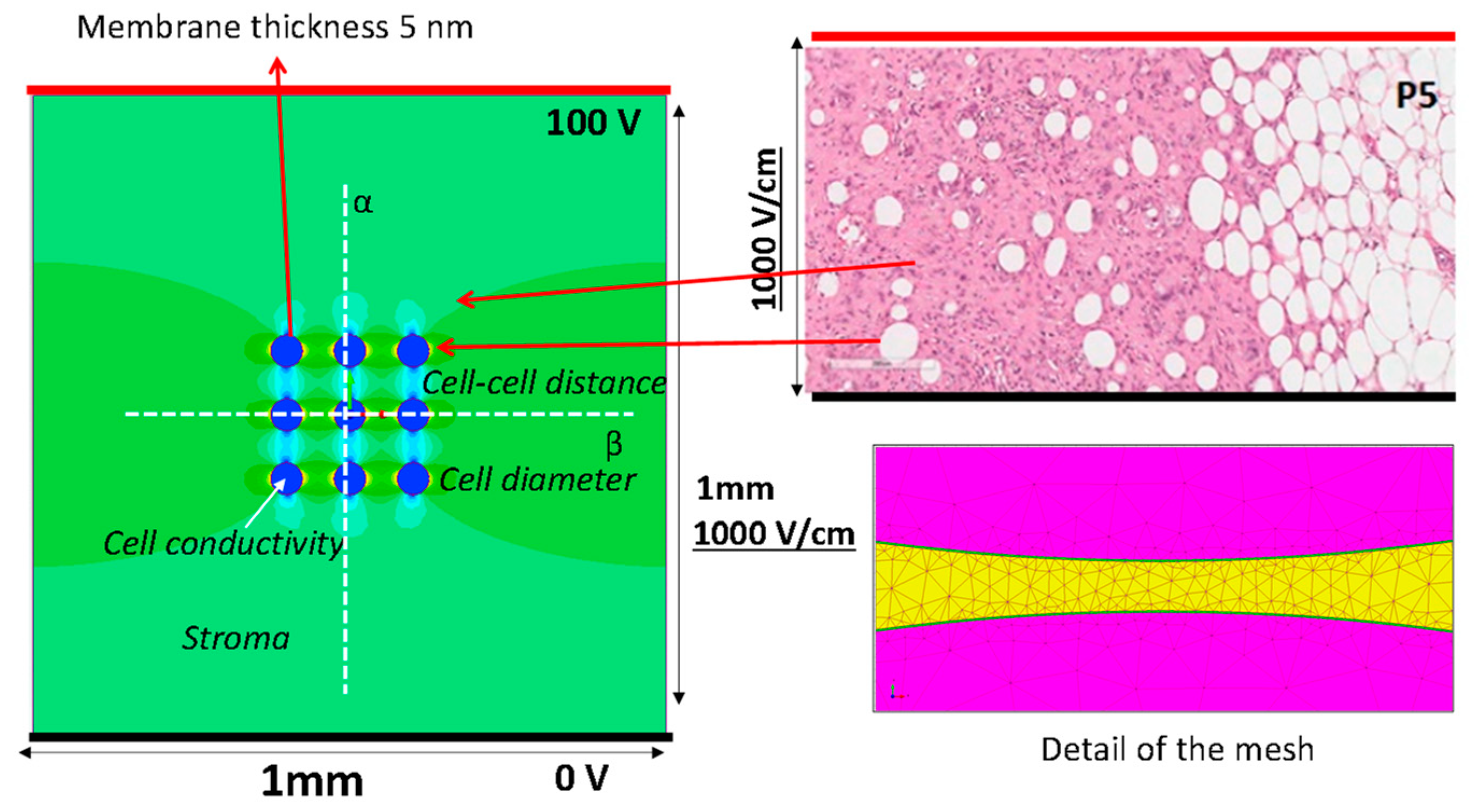
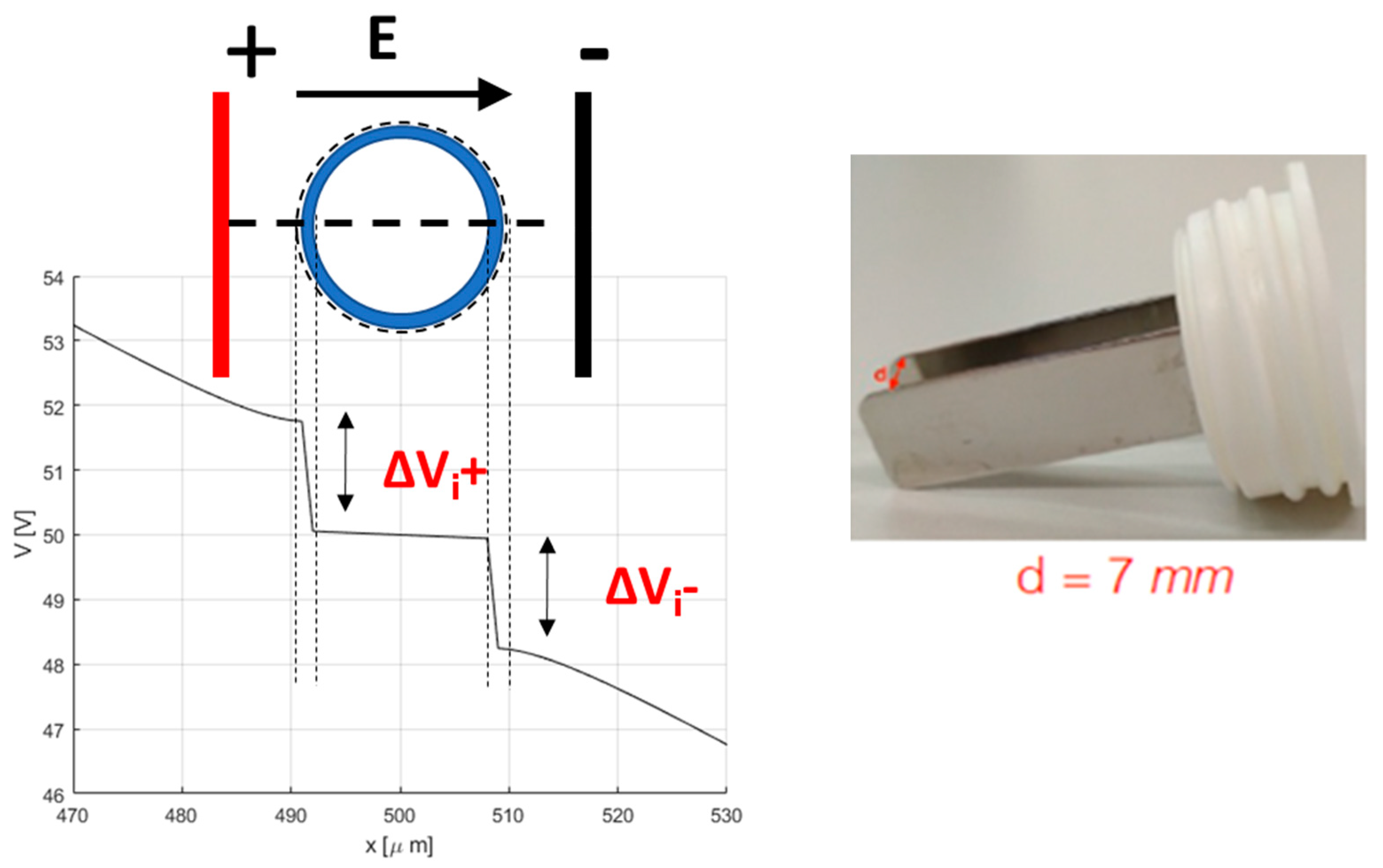
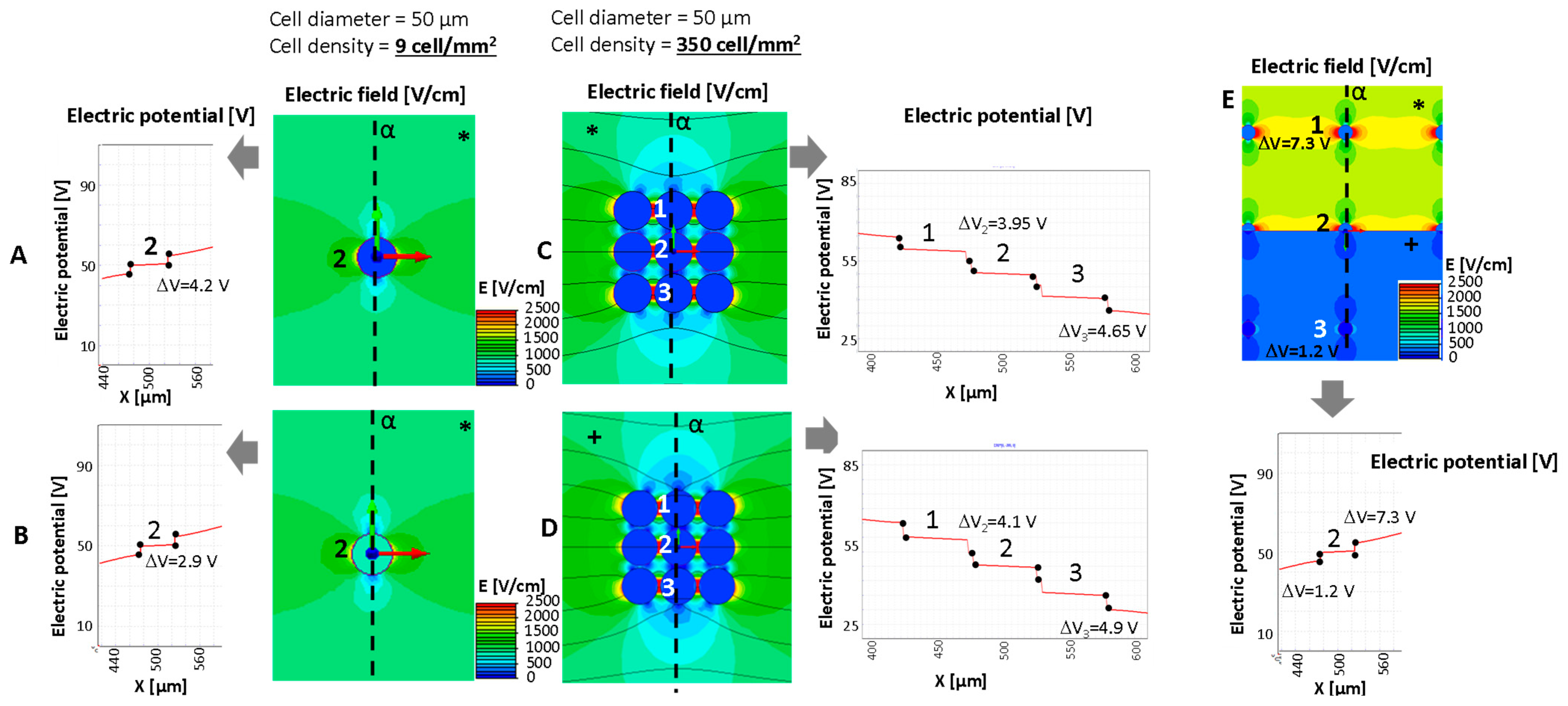
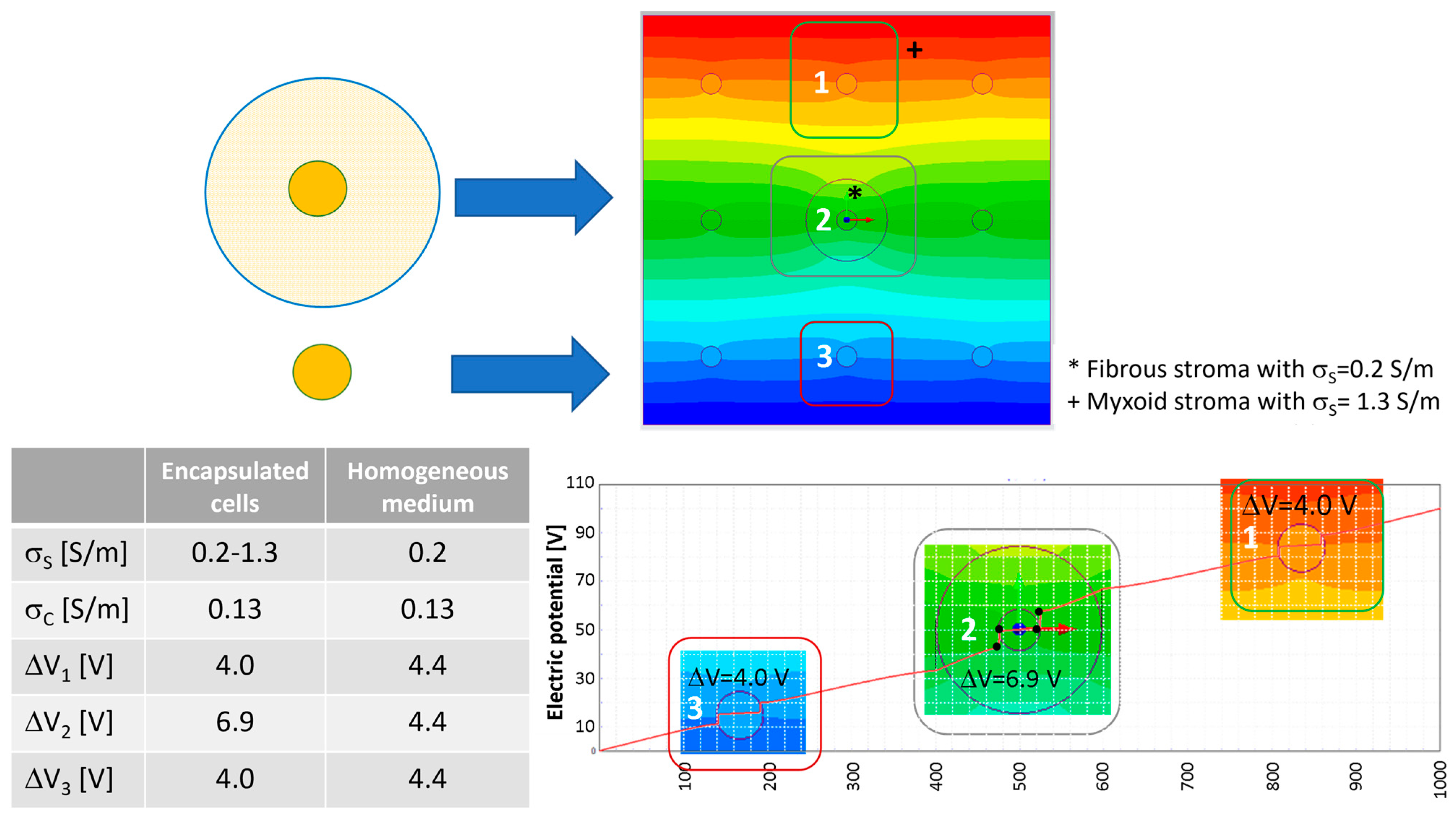
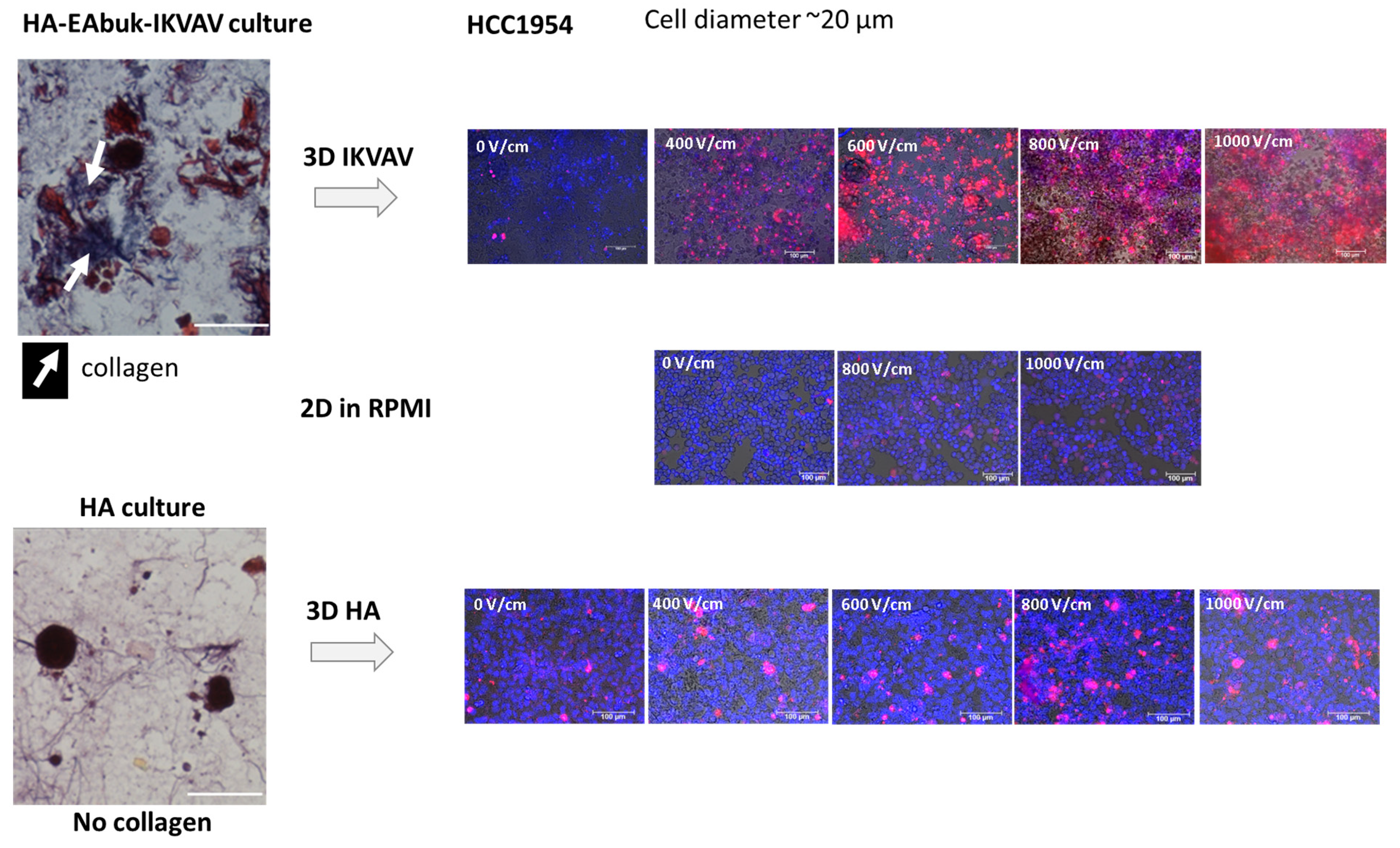
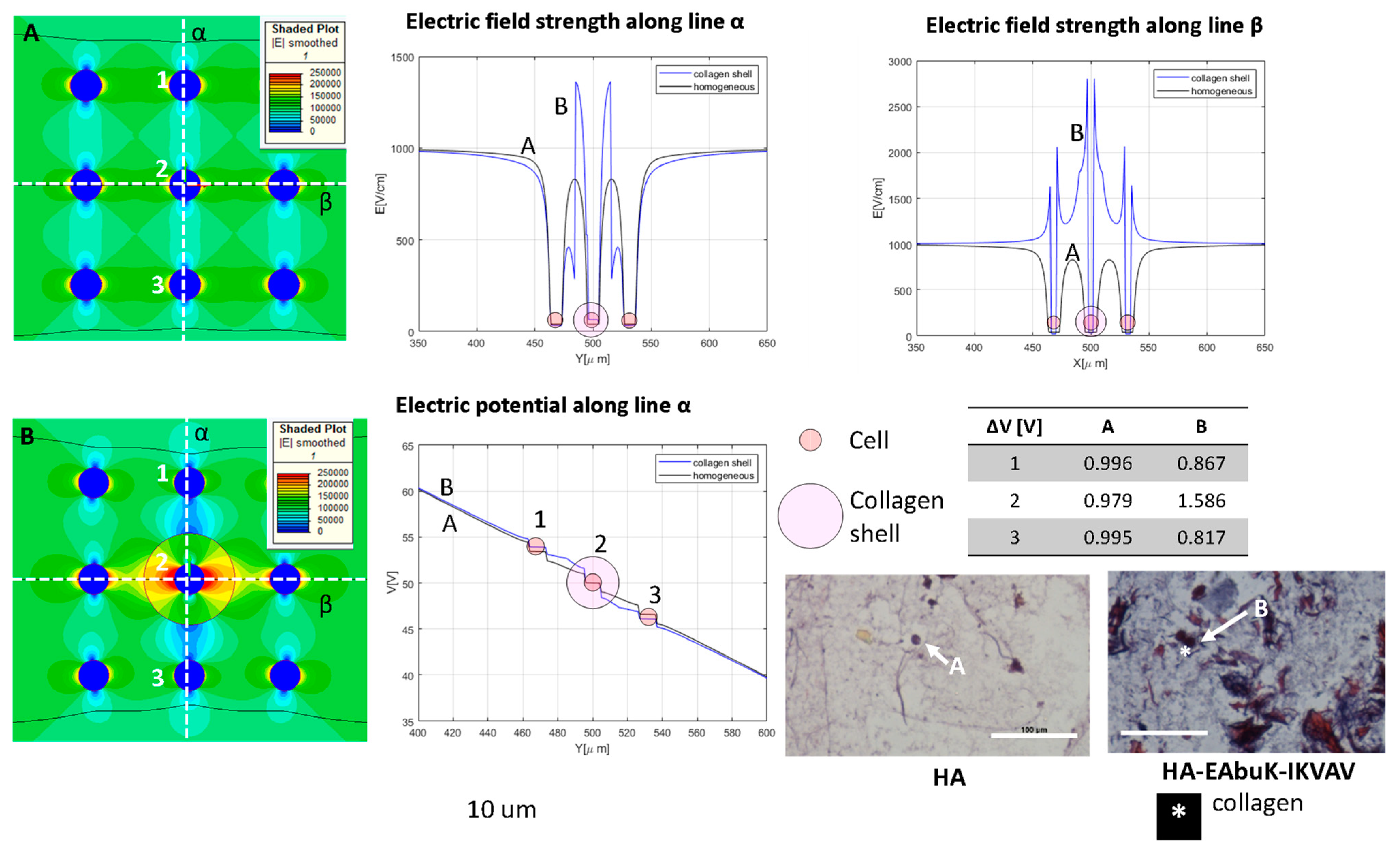
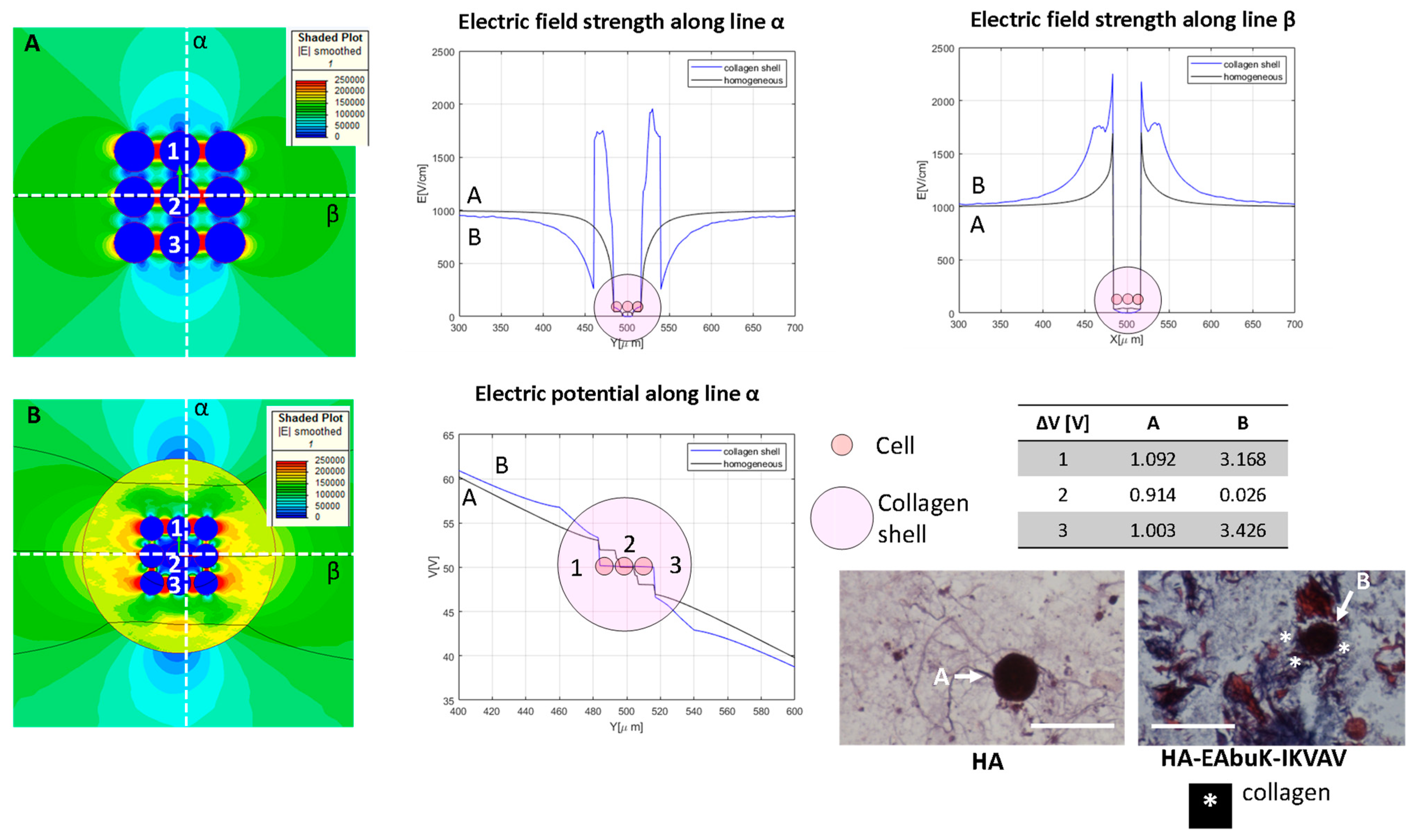
| A | B | C | D | E * | F | G | H | I | L | M | |
|---|---|---|---|---|---|---|---|---|---|---|---|
| σS [S/m] | 0.2 | 0.2 | 0.2 | 1.3 | 0.2/1.3 | 0.13 | 0.2 | 1.3 | 0.2 | 1.3 | 1.3 |
| σC [S/m] | 0.13 | 0.02 | 0.13 | 0.13 | 0.13 | 0.13 | 0.13 | 0.13 | 0.13 | 0.13 | 0.13 |
| Cell diameter [μm], CD | 50 | 50 | 50 | 50 | 50 | 50 | 10 | 10 | 10 | 10 | 10 |
| Cell local density [cell/mm2], CLD | 9 | 9 | 350 | 350 | 9 | 9 | 1000 | 1000 | 100 | 100 | 8000 |
| Cell–cell distance [μm], CCD | 283 | 283 | 3.5 | 3.5 | 283 | 283 | 21.6 | 21.6 | 90 | 90 | 1.2 |
| Cell/cell-group shell | Y | N | N | N | N | N | N | Y | N | N | Y |
| A | B | C | D | E * | F | G | H | I | L | M | |
|---|---|---|---|---|---|---|---|---|---|---|---|
| σ(S) [S/m] | 0.2 | 0.2 | 0.2 | 1.3 | 0.2/1.3 | 1.3 | 0.2 | 1.3 | 0.2 | 1.3 | 1.3 |
| σ(C) [S/m] | 0.13 | 0.02 | 0.13 | 0.13 | 0.13 | 0.13 | 0.13 | 0.13 | 0.13 | 0.13 | 0.13 |
| CD [μm] | 50 | 50 | 50 | 50 | 50 | 50 | 10 | 10 | 10 | 10 | 10 |
| CLD [cell/mm2] | 9 | 9 | 350 | 350 | 9 | 9 | 1000 | 1000 | 100 | 100 | 8000 |
| ΔV(2) central | 4.2 | 2.9 | 3.95 | 4.1 | 7.3–1.2 | 4.4 | 0.968 | 0.979 | 0.968 | 0.977 | 0.914 |
| ΔV(1) external | 4.2 | 2.9 | 4.65 | 4.9 | 7.3 | 4.4 | 0.987 | 0.996 | 0.971 | 0.981 | 1.092 |
| ΔV(3) external | 4.2 | 2.9 | 4.65 | 4.9 | 1.2 | 4.4 | 0.987 | 0.995 | 0.971 | 0.981 | 1.003 |
Disclaimer/Publisher’s Note: The statements, opinions and data contained in all publications are solely those of the individual author(s) and contributor(s) and not of MDPI and/or the editor(s). MDPI and/or the editor(s) disclaim responsibility for any injury to people or property resulting from any ideas, methods, instructions or products referred to in the content. |
© 2023 by the authors. Licensee MDPI, Basel, Switzerland. This article is an open access article distributed under the terms and conditions of the Creative Commons Attribution (CC BY) license (https://creativecommons.org/licenses/by/4.0/).
Share and Cite
Sieni, E.; Dettin, M.; Zamuner, A.; Conconi, M.T.; Bazzolo, B.; Balducci, C.; Di Barba, P.; Forzan, M.; Lamberti, P.; Mognaschi, M.E. Finite Element Evaluation of the Electric Field Distribution in a Non-Homogeneous Environment. Bioengineering 2023, 10, 1062. https://doi.org/10.3390/bioengineering10091062
Sieni E, Dettin M, Zamuner A, Conconi MT, Bazzolo B, Balducci C, Di Barba P, Forzan M, Lamberti P, Mognaschi ME. Finite Element Evaluation of the Electric Field Distribution in a Non-Homogeneous Environment. Bioengineering. 2023; 10(9):1062. https://doi.org/10.3390/bioengineering10091062
Chicago/Turabian StyleSieni, Elisabetta, Monica Dettin, Annj Zamuner, Maria Teresa Conconi, Bianca Bazzolo, Cristian Balducci, Paolo Di Barba, Michele Forzan, Patrizia Lamberti, and Maria Evelina Mognaschi. 2023. "Finite Element Evaluation of the Electric Field Distribution in a Non-Homogeneous Environment" Bioengineering 10, no. 9: 1062. https://doi.org/10.3390/bioengineering10091062
APA StyleSieni, E., Dettin, M., Zamuner, A., Conconi, M. T., Bazzolo, B., Balducci, C., Di Barba, P., Forzan, M., Lamberti, P., & Mognaschi, M. E. (2023). Finite Element Evaluation of the Electric Field Distribution in a Non-Homogeneous Environment. Bioengineering, 10(9), 1062. https://doi.org/10.3390/bioengineering10091062















